All Exams >
JAMB >
Biology for JAMB >
All Questions
All questions of The Ecology of Population for JAMB Exam
The birth and death rates of four counteries are given below. which one will have the least population growth rate?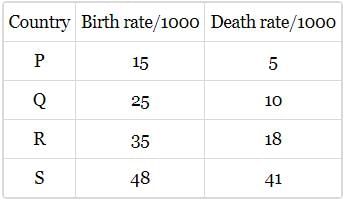
- a)P
- b)Q
- c)R
- d)S
Correct answer is option 'D'. Can you explain this answer?
The birth and death rates of four counteries are given below. which one will have the least population growth rate?

a)
P
b)
Q
c)
R
d)
S

|
Top Rankers answered |
Growth rate = Birth rate - death rate
For country P, it is 10/1000. For country Q, It is 15/1000
For country R, it is 17/1000. For country S, It is 7/1000
Hence, country S has the least population growth rate
For country P, it is 10/1000. For country Q, It is 15/1000
For country R, it is 17/1000. For country S, It is 7/1000
Hence, country S has the least population growth rate
In a pond, last year there were 30 lotus plants. Through reproduction, 25 new lotus plants were added in one year while 8 plants died. The birth and death rates for the lotus population respectively are ___ and ____ individuals per lotus per year.- a)0.83 , 0.26
- b)0.26, 0.83
- c)0.25 , 0.80
- d)0.80, 0.25
Correct answer is option 'A'. Can you explain this answer?
In a pond, last year there were 30 lotus plants. Through reproduction, 25 new lotus plants were added in one year while 8 plants died. The birth and death rates for the lotus population respectively are ___ and ____ individuals per lotus per year.
a)
0.83 , 0.26
b)
0.26, 0.83
c)
0.25 , 0.80
d)
0.80, 0.25

|
Abha Dhamija answered |
Total number of plants (in the beginning ) = 30
New plants added by reproduction = 25
Birth rate (of a population)
New plants added by reproduction = 25
Birth rate (of a population)

=0.83 individuals per lotus per year
Number of plants died =8

Correct sequence of stages of succession on a bare rock is- a)Lichens → Mosses → Grasses → Shrubs → Trees
- b)Trees → Shrubs→ Lichens → Mosses → Grasses
- c)Mosses Shrubs → Trees→ Lichens → Grasses
- d)Mosses → Lichens → Grasses → Shrubs → Trees
Correct answer is option 'A'. Can you explain this answer?
Correct sequence of stages of succession on a bare rock is
a)
Lichens → Mosses → Grasses → Shrubs → Trees
b)
Trees → Shrubs→ Lichens → Mosses → Grasses
c)
Mosses Shrubs → Trees→ Lichens → Grasses
d)
Mosses → Lichens → Grasses → Shrubs → Trees
|
|
Mira Joshi answered |
The various serai stages of lithosere (succession on bare rock) are as follows:
Lichens (Pioneer community) → Mosses → Annual grasses→ Perennial grasses → Shrubs → Trees (Climax community).
Lichens (Pioneer community) → Mosses → Annual grasses→ Perennial grasses → Shrubs → Trees (Climax community).
In a population per capita birth rate is 0.15 and per capita death rate is 0.08 during a unit time period. What is the value of r (intrinsic rate of natural increase) for the given population ?- a)0.023
- b)0.07
- c)0.05
- d)0.25
Correct answer is option 'B'. Can you explain this answer?
In a population per capita birth rate is 0.15 and per capita death rate is 0.08 during a unit time period. What is the value of r (intrinsic rate of natural increase) for the given population ?
a)
0.023
b)
0.07
c)
0.05
d)
0.25

|
EduRev NEET answered |
Intrinsic rate of natural increase (r)
= Birth rate − death rate
=0.15−0.08=0.07
Read the given statements and select the correct option.
Statement 1: Pioneer community is the stable and final biotic community of an ecological succession.
Statement 2: Pioneer community has maximum diversity and niche specialisation.- a)Both statement 1 and 2 are correct and statement 2 is the correct explanation of statement 1.
- b)Both statement 1 and 2 are correct and statement 2 is not the correct explanation of statement 1.
- c)Statement 1 is correct and statement 2 is incorrect.
- d)Both statements 1 and 2 are incorrect.
Correct answer is option 'D'. Can you explain this answer?
Read the given statements and select the correct option.
Statement 1: Pioneer community is the stable and final biotic community of an ecological succession.
Statement 2: Pioneer community has maximum diversity and niche specialisation.
Statement 1: Pioneer community is the stable and final biotic community of an ecological succession.
Statement 2: Pioneer community has maximum diversity and niche specialisation.
a)
Both statement 1 and 2 are correct and statement 2 is the correct explanation of statement 1.
b)
Both statement 1 and 2 are correct and statement 2 is not the correct explanation of statement 1.
c)
Statement 1 is correct and statement 2 is incorrect.
d)
Both statements 1 and 2 are incorrect.
|
|
Dev Patel answered |
Pioneer community is the first community to inhabit an area while the last stable community of an ecological succession is climax community. Climax community has the maximum diversity and niche specialisation.
If N population density at time t, then population density at time t+1 can be written asNt +1=Nt +[(A+B)−(C+D)]
Select the correct option for A, B, C and D in the above equation. - a)A can be mortality and B can be natality
- b)B can be immigration and C can be natality
- c)C can be mortality and D can be immigration
- d)A can be natality and D can be emigration
Correct answer is option 'D'. Can you explain this answer?
If N population density at time t, then population density at time t+1 can be written as
Nt +1=Nt +[(A+B)−(C+D)]
Select the correct option for A, B, C and D in the above equation.
Select the correct option for A, B, C and D in the above equation.
a)
A can be mortality and B can be natality
b)
B can be immigration and C can be natality
c)
C can be mortality and D can be immigration
d)
A can be natality and D can be emigration
|
|
Jyoti Sengupta answered |
A and B are natality and immigration. They add to population density. C and D are mortality and emigration. They decrease population density.
Which of the following is not a factor that would limit the growth of a population ?- a)Food shortage
- b)Immigration
- c)Disease
- d)Famine
Correct answer is option 'B'. Can you explain this answer?
Which of the following is not a factor that would limit the growth of a population ?
a)
Food shortage
b)
Immigration
c)
Disease
d)
Famine
|
|
Dev Patel answered |
Immigration is the permanent inward movement of some individuals coming from outside into an existing population. This increase population density and would not limit its growth.
Which of the following is not an example of prey-predator relationship ?- a)Tiger eating a deer
- b)Plant Nepenthes trapping an insect
- c)Bacteria decomposing organic matter
- d)Crocodile killing a man
Correct answer is option 'C'. Can you explain this answer?
Which of the following is not an example of prey-predator relationship ?
a)
Tiger eating a deer
b)
Plant Nepenthes trapping an insect
c)
Bacteria decomposing organic matter
d)
Crocodile killing a man
|
|
Mira Joshi answered |
Bacteria decompose the organic matter which is not really living. Hence, it cannot be considered as a prey predator relationship.
Choose the wrong statements
- a)Two species may not live in same habitat
- b)The more dissimilar the niches of two species the stronger is their competition between them
- c)No two species can occupy exactly the same niche in the same geographical area
- d)All of these
Correct answer is option 'C'. Can you explain this answer?
Choose the wrong statements
a)
Two species may not live in same habitat
b)
The more dissimilar the niches of two species the stronger is their competition between them
c)
No two species can occupy exactly the same niche in the same geographical area
d)
All of these
|
|
Dev Patel answered |
According to the competitive exclusion principle, no two species can occupy exactly the same niche in exactly the same habitat at exactly the same time. Two species whose niches overlap may evolve by natural selection to have more distinct niches, resulting in resource partitioning.
So the correct answer is 'No two species can occupy exactly the same niche in the same geographical area.'
Exponential growth is observed in a population when- a)resources in the habitat are unlimited
- b)each species has the ability to realise its full innate potential
- c)both (a) and (b)
- d)none of these
Correct answer is option 'C'. Can you explain this answer?
Exponential growth is observed in a population when
a)
resources in the habitat are unlimited
b)
each species has the ability to realise its full innate potential
c)
both (a) and (b)
d)
none of these
|
|
Raghav Bansal answered |
When food and space for a population are unlimited, each species has the ability to realise fully its inherited potential to grow. Then the population grows in an exponential or geometric ratio.
A population with a larger proportion of older individuals than younger ones will likely to- a)grow larger and then decline
- b)continue to grow larger indefinitely
- c)grow smaller and may stabilize at a smaller population size
- d)not experience a change in population size.
Correct answer is option 'C'. Can you explain this answer?
A population with a larger proportion of older individuals than younger ones will likely to
a)
grow larger and then decline
b)
continue to grow larger indefinitely
c)
grow smaller and may stabilize at a smaller population size
d)
not experience a change in population size.
|
|
Anand Chaudhary answered |
Understanding Population Dynamics
A population with a larger proportion of older individuals is likely to face specific dynamics that influence its growth and stability.
Reasons for Option C: Grow Smaller and May Stabilize
- Higher Mortality Rates: Older individuals typically have shorter life expectancies, leading to increased mortality rates within this demographic. As these individuals age and pass away, the population will naturally decline.
- Lower Birth Rates: Populations with a higher proportion of older individuals often have lower birth rates, as older individuals are less likely to contribute to population growth. When fewer young individuals are born, the population's potential for growth diminishes.
- Age Structure Impact: The age structure of a population significantly influences its future growth. A population with more older individuals and fewer younger ones tends to transition towards stabilization or decline as the reproductive base shrinks.
- Potential for Stabilization: As the population decreases, it may reach a point of stabilization at a smaller size, given that the birth rates remain low and death rates may fluctuate based on health and environmental factors.
Conclusion
In summary, a population skewed towards older individuals is likely to experience a decline due to higher mortality and lower birth rates, potentially stabilizing at a smaller size. Hence, option C accurately reflects the expected demographic trends in such populations.
A population with a larger proportion of older individuals is likely to face specific dynamics that influence its growth and stability.
Reasons for Option C: Grow Smaller and May Stabilize
- Higher Mortality Rates: Older individuals typically have shorter life expectancies, leading to increased mortality rates within this demographic. As these individuals age and pass away, the population will naturally decline.
- Lower Birth Rates: Populations with a higher proportion of older individuals often have lower birth rates, as older individuals are less likely to contribute to population growth. When fewer young individuals are born, the population's potential for growth diminishes.
- Age Structure Impact: The age structure of a population significantly influences its future growth. A population with more older individuals and fewer younger ones tends to transition towards stabilization or decline as the reproductive base shrinks.
- Potential for Stabilization: As the population decreases, it may reach a point of stabilization at a smaller size, given that the birth rates remain low and death rates may fluctuate based on health and environmental factors.
Conclusion
In summary, a population skewed towards older individuals is likely to experience a decline due to higher mortality and lower birth rates, potentially stabilizing at a smaller size. Hence, option C accurately reflects the expected demographic trends in such populations.
The density of a population in a given habitat during a given period, fluctuates due to changes in certain basic processes. On this basis, fill up boxes A and B in the given flow chart with correct option.
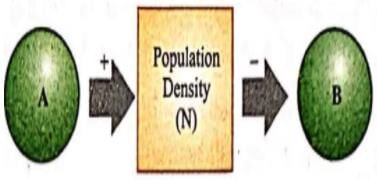
- a)A — Natality, B — Mortality
- b)A — Immigration , B — Emigration
- c)A — Natality, B — Immigration
- d)Both (a) and (b)
Correct answer is option 'D'. Can you explain this answer?
The density of a population in a given habitat during a given period, fluctuates due to changes in certain basic processes. On this basis, fill up boxes A and B in the given flow chart with correct option.

a)
A — Natality, B — Mortality
b)
A — Immigration , B — Emigration
c)
A — Natality, B — Immigration
d)
Both (a) and (b)
|
|
Ananya Das answered |
The population density in a given habitat and at a particular time period, fluctuates due to the changes in four basic processes given below:-
1. Natality- It refers to the number of births take place in a population during a given period.
2. Mortality- It refers to the number of deaths take place in a population during a given period.
3. Immigration- It refers to the number of individuals of the same species have migrated into the habitat from somewhere else during a particular time period.
4. Emigration- It refers to the number of individuals of the same species have migrated out of the habitat during a given time period.
Natality and immigration add to the population density whereas mortality and emigration decrease the population density.
Second stage of hydrosere is occupied by plants like- a)Azolla
- b)Typha
- c)Carex
- d)Vallisneria
Correct answer is option 'D'. Can you explain this answer?
Second stage of hydrosere is occupied by plants like
a)
Azolla
b)
Typha
c)
Carex
d)
Vallisneria
|
|
Rahul Das answered |
The second stage of hydrosere is occupied by plants like Vallisneria. Let's understand why Vallisneria is the correct answer and the characteristics of this plant.
Vallisneria is a submerged aquatic plant commonly known as eelgrass or tape grass. It belongs to the family Hydrocharitaceae. This plant is well-adapted to grow in freshwater bodies such as ponds, lakes, and slow-moving streams. It plays a significant role in the second stage of hydrosere succession.
Here are the reasons why Vallisneria is the correct answer for the second stage of hydrosere:
1. Submerged Growth: Vallisneria is a submerged aquatic plant, which means it grows entirely underwater. Its long, ribbon-like leaves float in the water column, allowing it to photosynthesize efficiently.
2. Oxygenation: Vallisneria helps in oxygenating the water by releasing oxygen during photosynthesis. This is crucial for promoting the growth of other organisms in the water ecosystem.
3. Nutrient Uptake: Vallisneria has an extensive root system that helps in the uptake of nutrients from the water. It absorbs nutrients like nitrogen and phosphorus, which are essential for plant growth, thereby reducing their availability for algae and other unwanted organisms.
4. Filtration: Vallisneria acts as a natural water filter. Its dense growth helps in reducing suspended particles and sediments in the water, improving water clarity and quality.
5. Habitat and Protection: Vallisneria provides a suitable habitat for various aquatic organisms such as small fish, invertebrates, and microorganisms. It offers them shelter, protection, and a place to reproduce.
6. Stabilization: The roots of Vallisneria anchor it firmly in the substrate, preventing soil erosion in the water body. It helps in stabilizing the sediment and maintaining the overall ecosystem balance.
Overall, Vallisneria is a crucial plant in the second stage of hydrosere as it contributes to the ecological balance of freshwater bodies by oxygenating the water, nutrient uptake, filtration, providing habitat, and stabilizing the substrate.
Vallisneria is a submerged aquatic plant commonly known as eelgrass or tape grass. It belongs to the family Hydrocharitaceae. This plant is well-adapted to grow in freshwater bodies such as ponds, lakes, and slow-moving streams. It plays a significant role in the second stage of hydrosere succession.
Here are the reasons why Vallisneria is the correct answer for the second stage of hydrosere:
1. Submerged Growth: Vallisneria is a submerged aquatic plant, which means it grows entirely underwater. Its long, ribbon-like leaves float in the water column, allowing it to photosynthesize efficiently.
2. Oxygenation: Vallisneria helps in oxygenating the water by releasing oxygen during photosynthesis. This is crucial for promoting the growth of other organisms in the water ecosystem.
3. Nutrient Uptake: Vallisneria has an extensive root system that helps in the uptake of nutrients from the water. It absorbs nutrients like nitrogen and phosphorus, which are essential for plant growth, thereby reducing their availability for algae and other unwanted organisms.
4. Filtration: Vallisneria acts as a natural water filter. Its dense growth helps in reducing suspended particles and sediments in the water, improving water clarity and quality.
5. Habitat and Protection: Vallisneria provides a suitable habitat for various aquatic organisms such as small fish, invertebrates, and microorganisms. It offers them shelter, protection, and a place to reproduce.
6. Stabilization: The roots of Vallisneria anchor it firmly in the substrate, preventing soil erosion in the water body. It helps in stabilizing the sediment and maintaining the overall ecosystem balance.
Overall, Vallisneria is a crucial plant in the second stage of hydrosere as it contributes to the ecological balance of freshwater bodies by oxygenating the water, nutrient uptake, filtration, providing habitat, and stabilizing the substrate.
Which of the following is not an example of using relative density to measure population density in a certain area ?- a)Counting pugmarks of tigers to find population density of tigers in a forest
- b)Counting the number of fishes caught in a trap to find population density of fishes in a lake
- c)Measuring biomass of bacterial culture to find out population density of bacteria in a petri dish
- d)Measuring biomass of phytoplanktons in 1cc water to find out population density of phytoplanktons in a lake
Correct answer is option 'C'. Can you explain this answer?
Which of the following is not an example of using relative density to measure population density in a certain area ?
a)
Counting pugmarks of tigers to find population density of tigers in a forest
b)
Counting the number of fishes caught in a trap to find population density of fishes in a lake
c)
Measuring biomass of bacterial culture to find out population density of bacteria in a petri dish
d)
Measuring biomass of phytoplanktons in 1cc water to find out population density of phytoplanktons in a lake
|
|
Geetika Shah answered |
Sometimes, for certain ecological investigations, there is no need to know the absolute population densities. Relative densities serve the purpose equally well. In this case, population size is indirectly estimated without actually counting them. For example, the number of fishes caught per trap is good enough measure of its total population density in the lake. The tiger census in our National parks and tiger reserves is often based on pug marks (animal's foot print) and faecal pellets.
Total number of individuals of a species per unit area and per unit time is called:- a)Population size
- b)Population density
- c)Demography
- d)Population dynamics
Correct answer is option 'B'. Can you explain this answer?
Total number of individuals of a species per unit area and per unit time is called:
a)
Population size
b)
Population density
c)
Demography
d)
Population dynamics
|
|
Chirag Unni answered |
Understanding Population Density
Population density is a crucial ecological concept that quantifies the number of individuals of a species within a specific area and timeframe.
Definition of Population Density
- Population density is defined as the total number of individuals of a species per unit area (e.g., per square kilometer) and per unit time (e.g., per year).
- It reflects how crowded a species is in a particular habitat, providing insight into resource availability, competition, and social structure.
Importance of Population Density
- Ecological Balance: Population density helps ecologists understand the balance within an ecosystem. High densities may indicate healthy breeding conditions, while low densities can signify environmental stress.
- Resource Management: Knowledge of population density is vital for wildlife management and conservation efforts, as it aids in assessing the sustainability of populations and the impact of human activities.
- Behavioral Insights: Studying population density allows researchers to examine social behaviors, territoriality, and interactions among species, which are influenced by how closely individuals are packed together.
Comparison with Other Terms
- Population Size: Refers only to the total number of individuals, without considering the area or time.
- Demography: Involves the statistical study of populations, including their structures and dynamics, but does not specifically focus on density.
- Population Dynamics: Encompasses the changes in population size and composition over time, influenced by birth rates, death rates, immigration, and emigration.
Understanding the concept of population density is essential for comprehending ecological relationships and managing biological resources effectively.
Population density is a crucial ecological concept that quantifies the number of individuals of a species within a specific area and timeframe.
Definition of Population Density
- Population density is defined as the total number of individuals of a species per unit area (e.g., per square kilometer) and per unit time (e.g., per year).
- It reflects how crowded a species is in a particular habitat, providing insight into resource availability, competition, and social structure.
Importance of Population Density
- Ecological Balance: Population density helps ecologists understand the balance within an ecosystem. High densities may indicate healthy breeding conditions, while low densities can signify environmental stress.
- Resource Management: Knowledge of population density is vital for wildlife management and conservation efforts, as it aids in assessing the sustainability of populations and the impact of human activities.
- Behavioral Insights: Studying population density allows researchers to examine social behaviors, territoriality, and interactions among species, which are influenced by how closely individuals are packed together.
Comparison with Other Terms
- Population Size: Refers only to the total number of individuals, without considering the area or time.
- Demography: Involves the statistical study of populations, including their structures and dynamics, but does not specifically focus on density.
- Population Dynamics: Encompasses the changes in population size and composition over time, influenced by birth rates, death rates, immigration, and emigration.
Understanding the concept of population density is essential for comprehending ecological relationships and managing biological resources effectively.
Read the following statements and select the correct option.
Statement 1: Brood parasitism in birds is an example of parasitism in which the parasitic bird lays its eggs in the nest of its host and the host incubates them.
Statement 2: During the course of evolution, the eggs of the parasite bird have evolved to resemble the host's eggs in size and colour to reduce the chances of the host bird detecting the foreign eggs and removing them from the nest.
- a)Statement 1 is correct but statement 2 is incorrect but statement 2 is not correct explanation of statement 1
- b)Both statements 1 and 2 are correct and statement 2 is the correct explanation of statement 1
- c)Statement 1 is correct but statement 2 is incorrect
- d)Both statements 1 and 2 are incorrect
Correct answer is option 'B'. Can you explain this answer?
Read the following statements and select the correct option.
Statement 1: Brood parasitism in birds is an example of parasitism in which the parasitic bird lays its eggs in the nest of its host and the host incubates them.
Statement 2: During the course of evolution, the eggs of the parasite bird have evolved to resemble the host's eggs in size and colour to reduce the chances of the host bird detecting the foreign eggs and removing them from the nest.
Statement 1: Brood parasitism in birds is an example of parasitism in which the parasitic bird lays its eggs in the nest of its host and the host incubates them.
Statement 2: During the course of evolution, the eggs of the parasite bird have evolved to resemble the host's eggs in size and colour to reduce the chances of the host bird detecting the foreign eggs and removing them from the nest.
a)
Statement 1 is correct but statement 2 is incorrect but statement 2 is not correct explanation of statement 1
b)
Both statements 1 and 2 are correct and statement 2 is the correct explanation of statement 1
c)
Statement 1 is correct but statement 2 is incorrect
d)
Both statements 1 and 2 are incorrect
|
|
Riya Banerjee answered |
The correct option is:
2. Both statements 1 and 2 are correct and statement 2 is the correct explanation of statement 1
Explanation:
- Statement 1 is correct: Brood parasitism in birds involves a parasitic bird laying its eggs in the nest of a host bird, and the host bird then incubates these eggs.
- Statement 2 is correct: During the course of evolution, the eggs of parasitic birds have evolved to resemble the host's eggs in size and color. This adaptation reduces the chances of the host bird detecting the foreign eggs and removing them from the nest.
Therefore, statement 2 provides the correct explanation for statement 1.
Which of the following equations correctly represents verhulst-Pearl logistic growth?- a)

- b)

- c)

- d)

Correct answer is option 'A'. Can you explain this answer?
Which of the following equations correctly represents verhulst-Pearl logistic growth?
a)

b)

c)

d)


|
EduRev NEET answered |
S-shaped growth curve is also called Verhulst-Pearl logistic curve and is represented by the following equation :

where dN/dt= rate of change in population size, r= intrinsic rate of natural increase, N= population density, K= carrying capacity and 

What does the shape of the given age pyramids reflects about the growth status of the related population ?
- a)(i) - Expanding (ii) - Stable
- b)(i) - Stable (ii) - Declining
- c)(i) - Expanding (ii) - Declining
- d)(i) - Declining (ii) - Stable
Correct answer is option 'C'. Can you explain this answer?
What does the shape of the given age pyramids reflects about the growth status of the related population ?

a)
(i) - Expanding (ii) - Stable
b)
(i) - Stable (ii) - Declining
c)
(i) - Expanding (ii) - Declining
d)
(i) - Declining (ii) - Stable

|
Diwakar Singh answered |
Triangular age pyramid has high proportion of reproductive individuals, moderate number of reproductive individuals and fewer post-reproductive individuals. It represents young or rapidly growing population.
In urn-shaped age pyramid, the number of reproductive individuals is higher than the number of pre-reproductive individuals. It represents declining or diminishing population with negative growth
In bell-shaped age pyramid, the number of pre-reproductive and reproductive individuals is almost equal. Post reproductive individuals are comparatively fewer. It represents stable or stationary population where growth rate is nearly zero.
Parameters related to age structure include- a)fecundity (birth rate)
- b)generation time
- c).Death rate
- d)all of these
Correct answer is option 'D'. Can you explain this answer?
Parameters related to age structure include
a)
fecundity (birth rate)
b)
generation time
c)
.Death rate
d)
all of these
|
|
Riya Banerjee answered |
The age structure of a population is the percentage of individuals of different ages such as young, adult and old.
Age structure is shown by organisms in which individuals of more than one generation time are important related to it.
Age structure is shown by organisms in which individuals of more than one generation time are important related to it.
Select the correct sequence of succession in a pond- a)Submerged plants → floating plants → Reed swamp stage → sedges
- b)Floating plants → submerged plants → Reed swamp stage → sedges
- c)Reed swamp stage → sedges→ floating plants → submerged plants
- d)Sedges → Reed swamp stage → floating plants → submerged plants
Correct answer is option 'A'. Can you explain this answer?
Select the correct sequence of succession in a pond
a)
Submerged plants → floating plants → Reed swamp stage → sedges
b)
Floating plants → submerged plants → Reed swamp stage → sedges
c)
Reed swamp stage → sedges→ floating plants → submerged plants
d)
Sedges → Reed swamp stage → floating plants → submerged plants
|
|
Preeti Iyer answered |
Series of biotic communities that develop in a newly formed pond or lake is called hydrosere. Various seral stages of hydrosere are:
Planktons (Phytoplanktons and zooplanktons) → rooted submerged hydrophytes → floating hydrophytes → reed swamps → sedges or marsh-meadow stage → woodland stage → climax forest.
Planktons (Phytoplanktons and zooplanktons) → rooted submerged hydrophytes → floating hydrophytes → reed swamps → sedges or marsh-meadow stage → woodland stage → climax forest.
In lithosere, foliose lichens make the conditions favourable for the growth of- a)crustose lichens
- b)mosses
- c)annual grasses
- d)perennial grasses
Correct answer is option 'B'. Can you explain this answer?
In lithosere, foliose lichens make the conditions favourable for the growth of
a)
crustose lichens
b)
mosses
c)
annual grasses
d)
perennial grasses
|
|
Muskan Khan answered |
IN LITHROSE ,THE PIONEERS COMMUNITY IS USUALLY CONSTITUTED BY CRUTOSE LICHENS ,FOLIOSE LICHENS KILL THE CRUTOSE LICHENS BY SHADING THEM CAUSE DEEPER DEPRESSION AND ACCUMULATE MORE SOIL PARTICLES AND ORGANIC MATTER.
The plant-animal interactions often involve co-evolution of the mutualists so that- a)the mutually beneficial system could be safeguarded against 'cheaters'
- b)a given plant species can be pollinated only by its partner animal species and no other species
- c)the animal utilises plant not only for ovipositions but also to pollinate the plant
- d)all of these
Correct answer is option 'D'. Can you explain this answer?
The plant-animal interactions often involve co-evolution of the mutualists so that
a)
the mutually beneficial system could be safeguarded against 'cheaters'
b)
a given plant species can be pollinated only by its partner animal species and no other species
c)
the animal utilises plant not only for ovipositions but also to pollinate the plant
d)
all of these
|
|
Anjali Sharma answered |
Plant-animal interactions involve co-evolution of mutualists. This means, the evolution of the plant (e.g., flower) and the animal (e.g. pollinator species) are closely linked with one another.
Obligate parasites are those organisms which- a)obtain nutrition from dead, decaying organic matter only
- b)obtain nutrition from living organism only
- c)are essentially saporphytes but can also become parasites
- d)are essentially parasites but can also become saprophytes
Correct answer is option 'B'. Can you explain this answer?
Obligate parasites are those organisms which
a)
obtain nutrition from dead, decaying organic matter only
b)
obtain nutrition from living organism only
c)
are essentially saporphytes but can also become parasites
d)
are essentially parasites but can also become saprophytes
|
|
Mira Joshi answered |
Parasitism is a relationship between two living organisms of different species in which one organism called parasite obtains its food directly from another living organism called host. The parasite is usually smaller as compared to its host. It spends a part or whole of its life on or in the body of the host. Obligate parasites obtain their nutrition from living organisms only.
The population growth is generally described by the following equation:

What does 'r' represent in the given equation ?- a)Population density at time 't'
- b)Intrinsic rate of natural increase
- c)Carrying capacity
- d)The base of natural logarithm
Correct answer is option 'B'. Can you explain this answer?
The population growth is generally described by the following equation:

What does 'r' represent in the given equation ?

What does 'r' represent in the given equation ?
a)
Population density at time 't'
b)
Intrinsic rate of natural increase
c)
Carrying capacity
d)
The base of natural logarithm
|
|
Riya Banerjee answered |
A population growing in a habitat with limited resources shows initially a lag phase, followed by phases of increase and decrease and finally the population density reaches the carrying capacity. A plot of N in relation to time (t) results in a sigmoid curve. This type of population growth is called Verhulst- Pearl Logistic Growth as explained by the following equation:

Where N = Population density at a time t;
r = Intrinsic rate of natural increase and;
K = Carrying capacity.
r = Intrinsic rate of natural increase and;
K = Carrying capacity.
Do humans exhibit any mutualistic relationships?- a)No humans form only parasitic relationships with other organisms
- b)No, humans are unable to form mutualistic relationships with other organisms
- c)Yes, between ourselves and the bacteria that make us ill
- d)Yes, between ourselves and the bacteria that live in our guts
Correct answer is option 'D'. Can you explain this answer?
Do humans exhibit any mutualistic relationships?
a)
No humans form only parasitic relationships with other organisms
b)
No, humans are unable to form mutualistic relationships with other organisms
c)
Yes, between ourselves and the bacteria that make us ill
d)
Yes, between ourselves and the bacteria that live in our guts
|
|
Suresh Iyer answered |
In mutualism, both species are benefitted. Gut bacteria are dependent on us for food. They release certain enzymes which help us in digestion.
Human cells contain mitochondria, which are responsible for producing the energy needed by our cells. Remember that the ancestors of mitochondria may once have been free-living prokaryotes. If mitochondria were still considered to be seperate organisms within our cells, which of the following would best describe our relationship with them?- a)Parasitic
- b)Mutualistic
- c)Competitive
- d)Pathogenic
Correct answer is option 'B'. Can you explain this answer?
Human cells contain mitochondria, which are responsible for producing the energy needed by our cells. Remember that the ancestors of mitochondria may once have been free-living prokaryotes. If mitochondria were still considered to be seperate organisms within our cells, which of the following would best describe our relationship with them?
a)
Parasitic
b)
Mutualistic
c)
Competitive
d)
Pathogenic
|
|
Mira Joshi answered |
If mitochondria are still considered to be separate organisms, they would form mutualistic relationship with us. This is because they would get the resources from us and in turn produce energy for various activities of the body.
The prickly pear cactus became unusually abundant after its introduction in Australia, because it _________________.- a)had no coevolved herbivores
- b)formed new mycorrhizal association
- c)lost its thorns
- d)all of these
Correct answer is option 'A'. Can you explain this answer?
The prickly pear cactus became unusually abundant after its introduction in Australia, because it _________________.
a)
had no coevolved herbivores
b)
formed new mycorrhizal association
c)
lost its thorns
d)
all of these
|
|
Anjali Sharma answered |
Coevolution is caused by the selection pressures that each of the two species exerts on the other. Since there has been no coevolved herbivore with prickly pear cactus, it became abundant in Australia.
The interdependent evolution of flowering plants and pollinating insects together is known as- a)mutualism
- b)co-evolution
- c)commensalism
- d)co-operation
Correct answer is option 'B'. Can you explain this answer?
The interdependent evolution of flowering plants and pollinating insects together is known as
a)
mutualism
b)
co-evolution
c)
commensalism
d)
co-operation
|
|
Riya Banerjee answered |
The evolution of complementary adaptations in two species caused by the selection pressures that each exerts on the other is called co-evolution. It is common in symbiotic associations e.g., many insect-pollinated plants have evolved flowers whose shapes, colours, etc., make them attractive to particular insects, at the same time the pollinating insects have evolved sense organs and mouth parts specialised for quickly locating and extracting nectar from particular species of plants.
Which of the following is a biotic factor that can regulate population sizes through predation?- a)Space
- b)Temperature
- c)Rainfall
- d)Predation
Correct answer is option 'D'. Can you explain this answer?
Which of the following is a biotic factor that can regulate population sizes through predation?
a)
Space
b)
Temperature
c)
Rainfall
d)
Predation
|
|
Deepak Iyer answered |
Predation (D) is a biotic factor that can regulate population sizes by controlling the abundance of prey species through predation. Space (A), temperature (B), and rainfall (C) are abiotic factors that may indirectly influence population sizes but do not regulate populations through predation.
During the stages of succession in a given ecosystem, the following changes in characteristics may be observed.
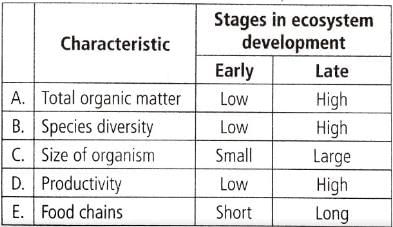 Which one of the characteristics A,B,C,D or E is responsible for the apparent high degree of stability associated with a climax ecosystem?
Which one of the characteristics A,B,C,D or E is responsible for the apparent high degree of stability associated with a climax ecosystem?- a)B
- b)D
- c)A
- d)E
Correct answer is option 'A'. Can you explain this answer?
During the stages of succession in a given ecosystem, the following changes in characteristics may be observed.


Which one of the characteristics A,B,C,D or E is responsible for the apparent high degree of stability associated with a climax ecosystem?
a)
B
b)
D
c)
A
d)
E
|
|
Lavanya Menon answered |
High species diversity is the most important factor in bringing stability to a climax ecosystem.
In a given population of 2000 individuals, 80 births and 125 deaths were reported over a given period of time. Which of the following graphs will correspond to it ?- a)
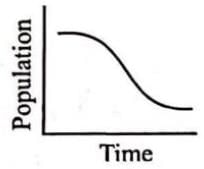
- b)
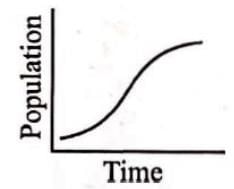
- c)
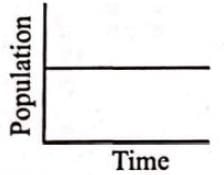
- d)
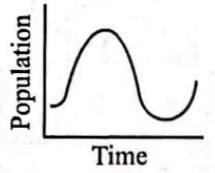
Correct answer is option 'A'. Can you explain this answer?
In a given population of 2000 individuals, 80 births and 125 deaths were reported over a given period of time. Which of the following graphs will correspond to it ?
a)

b)

c)

d)

|
|
Dev Patel answered |
Number of deaths is more than the number of births, showing a declining population.
In laboratory experiments, two species of the protist Paramecium (species 1 and 2) were grown alone and in the presence of the other species. The following graphs show growth of species 1 and species 2, both alone and when in mixed culture with the other species.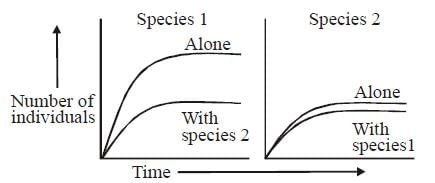 Which of the following conclusions can be drawn from the graphs ?
Which of the following conclusions can be drawn from the graphs ?- a)Competitive exclusion occurred in these experiments
- b)Both species are affected by interspecific competition but species 1 is affected less
- c)Both species are affected by interspecific competition but species 2 is affected less
- d)Both species are affected equally by interspecific competition
Correct answer is option 'C'. Can you explain this answer?
In laboratory experiments, two species of the protist Paramecium (species 1 and 2) were grown alone and in the presence of the other species. The following graphs show growth of species 1 and species 2, both alone and when in mixed culture with the other species.

Which of the following conclusions can be drawn from the graphs ?
a)
Competitive exclusion occurred in these experiments
b)
Both species are affected by interspecific competition but species 1 is affected less
c)
Both species are affected by interspecific competition but species 2 is affected less
d)
Both species are affected equally by interspecific competition
|
|
Anjali Sharma answered |
When species 1 was kept with species 2, its number of individuals fell drastically while when species 2 was kept with species 1, its number of individuals was not much affected. Hence, both species are affected by inter-specific competition but species 2 is less affected.
Study the population growth curves (A and B) in the given graph and select the incorrect option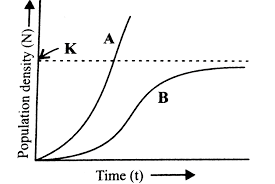
- a)Curve 'A' shows exponential growth, represented by equation dN/dt=rN
- b)Curve 'B' shows logistic growth, represented by equation

- c)Exponential growth curve is considered as more realistic than the logistic growth curve.
- d)Curve 'A' can also be represented by equation Nt=N0ert .
Correct answer is option 'C'. Can you explain this answer?
Study the population growth curves (A and B) in the given graph and select the incorrect option

a)
Curve 'A' shows exponential growth, represented by equation dN/dt=rN
b)
Curve 'B' shows logistic growth, represented by equation


c)
Exponential growth curve is considered as more realistic than the logistic growth curve.
d)
Curve 'A' can also be represented by equation Nt=N0ert .
|
|
Dev Patel answered |
Since resources of growth for most animal populations are finite and become limiting sooner or later, the logistic growth model is considered as more realistic.
Which of the following factors has a negative effect on the population growth rate ?- a)Emigration
- b)Immigration
- c)Natality
- d)Fecundity
Correct answer is option 'A'. Can you explain this answer?
Which of the following factors has a negative effect on the population growth rate ?
a)
Emigration
b)
Immigration
c)
Natality
d)
Fecundity
|
|
Jyoti Sengupta answered |
migration is permanent outward movement of individuals from a population for settlement into a new area. If decreases the local population.
The maximum possible number of individuals that a habitat can support is called its- a)fecundity
- b)surviving ability
- c)carrying capacity
- d)biotic potential
Correct answer is option 'C'. Can you explain this answer?
The maximum possible number of individuals that a habitat can support is called its
a)
fecundity
b)
surviving ability
c)
carrying capacity
d)
biotic potential
|
|
Jyoti Sengupta answered |
In nature, a given habitat has resources to support a certain number of individuals of a population, beyond which no further growth is possible. This limit is called as nature's carrying capacity (K) for that species in that habitat.
In the given figure, A,B,C,D,E and F represent some stages of hydrosere. Select the correct statement regarding these.
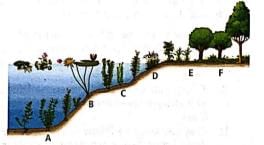
- a)Hydrilla and Potamogeton occur in stage A; Nymphaea and Nelumbo occur in stage B
- b)Phragmites and Typha occur in stage C; Carex and Cyperus dccur in stage D
- c)Alnus and Populus occur in stage E; Acer and Quercus occur in stage F
- d)All of these
Correct answer is option 'D'. Can you explain this answer?
In the given figure, A,B,C,D,E and F represent some stages of hydrosere. Select the correct statement regarding these.


a)
Hydrilla and Potamogeton occur in stage A; Nymphaea and Nelumbo occur in stage B
b)
Phragmites and Typha occur in stage C; Carex and Cyperus dccur in stage D
c)
Alnus and Populus occur in stage E; Acer and Quercus occur in stage F
d)
All of these
|
|
Vivek Patel answered |
In the given figure, A represents submerged stage (e.g., Hydrilla, Potamogeton, Vallisneria, etc.), B represents floating leaved anchored plant stage (e.g., Nymphaea, Nelumbo, Pistia, etc.), C represents reed-swamp stage (e.g., Phragmites, Typha, Scirpus, Sagittaria, etc.), D represents marsh-meadow stage (e.g., Carex, Cyperus, Juncus, etc.), E represents woodland stage (e.g., Salix, Populus, Alnus, etc.) and F represents the climax community of forest (e.g., Acer, Quercus, Ulmus, etc.).
Primary succession occurs on- a)area destroyed due to forest fire
- b)newly formed river delta
- c)harvested crop field
- d)all of these
Correct answer is option 'B'. Can you explain this answer?
Primary succession occurs on
a)
area destroyed due to forest fire
b)
newly formed river delta
c)
harvested crop field
d)
all of these
|
|
Suresh Iyer answered |
Primary succession starts from the primitive substratum, where previously there was not any sort of living matter. The first groups of plants establishing there are known as the pioneers, primary community or primary colonisers. Newly formed river delta, newly exposed sea floor, igneous rocks, sand dunes, new cooled lava sediments are some examples of primary bare area. Primary succession takes a long time for completion, several hundred to several thousand years.
Which of the following is an abiotic factor that can influence population sizes?- a)Predation
- b)Reproductive ability
- c)Space
- d)Competition
Correct answer is option 'C'. Can you explain this answer?
Which of the following is an abiotic factor that can influence population sizes?
a)
Predation
b)
Reproductive ability
c)
Space
d)
Competition
|
|
Deepak Iyer answered |
Abiotic factors are non-living components of an ecosystem. Space availability (C) is an abiotic factor that affects population sizes by limiting the physical area in which organisms can live. Predation (A), reproductive ability (B), and competition (D) are biotic factors as they involve interactions between living organisms.
The age structures of a population influences population growth because- a)younger females have more offsprings than do older females
- b)different ae groups have different reproductive capabilities
- c)more is the number of immature individuals, slower is the growth of population
- d)a shorter generation time results is slower population growth.
Correct answer is option 'B'. Can you explain this answer?
The age structures of a population influences population growth because
a)
younger females have more offsprings than do older females
b)
different ae groups have different reproductive capabilities
c)
more is the number of immature individuals, slower is the growth of population
d)
a shorter generation time results is slower population growth.
|
|
Hansa Sharma answered |
Different age groups have different reproductive capabilities. Pre-reproductive individuals are the young individuals which will enter the reproductive age after some time. They are the potential source of increas in population. Reproductive individuals are the ones which are actually adding neq members to the population. Post-reproductive individuals are older individuals which no longer take part in reproduction.
Refer to the given table that summarises the interactions between two organisms (organisms 1 and organism 2). Identify the types of interaction (A,B and C) and select the correct answer. (i) A can be either predation or parasitism
(i) A can be either predation or parasitism
(ii) B can be either commensalism
(iii) C can be amensalism.
(iv) A can be amensalism, - a)(i) and (ii)
- b)(ii) and (iii)
- c)(ii) and (iv)
- d)(i) and (iii)
Correct answer is option 'D'. Can you explain this answer?
Refer to the given table that summarises the interactions between two organisms (organisms 1 and organism 2). Identify the types of interaction (A,B and C) and select the correct answer.

(i) A can be either predation or parasitism
(ii) B can be either commensalism
(iii) C can be amensalism.
(iv) A can be amensalism,
(ii) B can be either commensalism
(iii) C can be amensalism.
(iv) A can be amensalism,
a)
(i) and (ii)
b)
(ii) and (iii)
c)
(ii) and (iv)
d)
(i) and (iii)
|
|
Mira Joshi answered |
A can be either predation or parasitism since one species is harmed and the other is benefitted. B is commensalism since one species is benefitted and other has no effect on it. C can be amensalism since one species is harmed and the other has no effect on it.
Which of the following is a biotic factor that can lead to competition among individuals in a population?- a)Rainfall
- b)pH
- c)Reproductive ability
- d)Space
Correct answer is option 'C'. Can you explain this answer?
Which of the following is a biotic factor that can lead to competition among individuals in a population?
a)
Rainfall
b)
pH
c)
Reproductive ability
d)
Space
|
|
Deepak Iyer answered |
Reproductive ability (C) is a biotic factor that can lead to competition among individuals within a population, as individuals compete for mates and reproductive resources. Rainfall (A), pH (B), and space (D) are abiotic factors that do not directly relate to competition among individuals.
Which of the following is a biotic factor that can influence population sizes through competition?- a)Rainfall
- b)Space
- c)Temperature
- d)pH
Correct answer is option 'B'. Can you explain this answer?
Which of the following is a biotic factor that can influence population sizes through competition?
a)
Rainfall
b)
Space
c)
Temperature
d)
pH
|
|
Deepak Iyer answered |
Space (B) is a biotic factor that can influence population sizes by determining the availability of physical areas for individuals to occupy, leading to competition for resources. Rainfall (A), temperature (C), and pH (D) are abiotic factors that do not directly relate to competition among individuals.
Which type of interaction is being shown in the given figure ?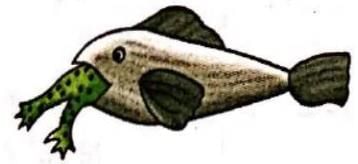
- a)Parasitism
- b)Commensalism
- c)Predation
- d)Amensalism
Correct answer is option 'C'. Can you explain this answer?
Which type of interaction is being shown in the given figure ?

a)
Parasitism
b)
Commensalism
c)
Predation
d)
Amensalism
|
|
Preeti Iyer answered |
Predation is an interaction between members of two species in which members of one species capture, kill and eat up members of other species. The former are called predators and the latter are called preys.
Refer to the given table. If '+' sign has been assigned for beneficial interaction, sign for detrimental interaction and '0' for neutral interaction, identify the type of interaction (i), (ii) and (iii) and select the correct option.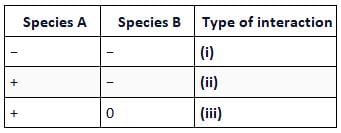
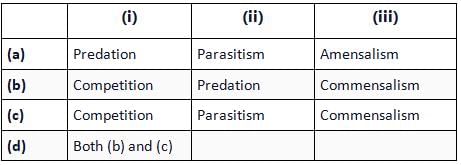
- a)a
- b)b
- c)c
- d)d
Correct answer is option 'D'. Can you explain this answer?
Refer to the given table. If '+' sign has been assigned for beneficial interaction, sign for detrimental interaction and '0' for neutral interaction, identify the type of interaction (i), (ii) and (iii) and select the correct option.


a)
a
b)
b
c)
c
d)
d
|
|
Suresh Iyer answered |
In competition, both species are harmed. In predation and parasitism, one species derives benefit and the other one is harmed. Commensalism is an interaction in which one species is benefitted and other one remains unaffected.
Percentage of individuals of a given age group in a given population is called as- a)age distribution
- b)age density
- c)age graph
- d)age curve
Correct answer is option 'A'. Can you explain this answer?
Percentage of individuals of a given age group in a given population is called as
a)
age distribution
b)
age density
c)
age graph
d)
age curve
|
|
Suresh Iyer answered |
Age distribution is percentage of individuals of a given age or age group. A population at any given time is composed of individuals of different ages. If age distribution is plotted for the population, the resulting structure is called as age pyramid.
Which of the following is an abiotic factor that can affect population sizes?- a)Pest infestation
- b)Disease outbreak
- c)Temperature
- d)Reproductive ability
Correct answer is option 'C'. Can you explain this answer?
Which of the following is an abiotic factor that can affect population sizes?
a)
Pest infestation
b)
Disease outbreak
c)
Temperature
d)
Reproductive ability
|
|
Deepak Iyer answered |
Abiotic factors like temperature (C) can directly influence population sizes by affecting the physiology and behavior of organisms. Pest infestation (A), disease outbreak (B), and reproductive ability (D) are biotic factors that involve interactions between organisms.
An ecosystem which can be easily damaged but can recover after some time if damaging effect stops will be having- a)Low stability and high resilience
- b)High stability and low resilience
- c)Low stability and low resilience
- d)High stability and high resilience
Correct answer is option 'A'. Can you explain this answer?
An ecosystem which can be easily damaged but can recover after some time if damaging effect stops will be having
a)
Low stability and high resilience
b)
High stability and low resilience
c)
Low stability and low resilience
d)
High stability and high resilience
|
|
Rohit Jain answered |
If an ecosystem is easily dameged, that means it is not very stable. But since, it recovers fast when the damaging effect stops, it certainly has high resilience.
Match column I with column II and select the correct option from the given codes.

- a)A−(iv), B−(ii), C−(i), D−(iii)
- b)A−(iv), B−(iii), C−(i), D−(ii)
- c)A−(i), B−(iii), C−(ii), D−(iv)
- d)A−(iv), B−(ii), C−(iii), D−(i)
Correct answer is option 'A'. Can you explain this answer?
Match column I with column II and select the correct option from the given codes.


a)
A−(iv), B−(ii), C−(i), D−(iii)
b)
A−(iv), B−(iii), C−(i), D−(ii)
c)
A−(i), B−(iii), C−(ii), D−(iv)
d)
A−(iv), B−(ii), C−(iii), D−(i)
|
|
Ananya Das answered |
Bacteria are important decomposers of ecosystem. Because of their small size, they are also called as micro consumers. Green plants (producers) are also called transducers because they convert light energy into chemical energy.
Primary succession (=Prisere) is the biotic succession that occurs on a previously bare area. Lithosere (or Xerosere) refers | to the sequence of successional stages that occur on bare rock.
Primary succession (=Prisere) is the biotic succession that occurs on a previously bare area. Lithosere (or Xerosere) refers | to the sequence of successional stages that occur on bare rock.
Which of the following is an abiotic factor that can affect population sizes?- a)Disease
- b)Competition
- c)pH
- d)Reproductive ability
Correct answer is option 'C'. Can you explain this answer?
Which of the following is an abiotic factor that can affect population sizes?
a)
Disease
b)
Competition
c)
pH
d)
Reproductive ability
|
|
Deepak Iyer answered |
pH (C) is an abiotic factor that can impact population sizes by affecting the availability of suitable habitats or influencing physiological processes in organisms. Disease (A), competition (B), and reproductive ability (D) are biotic factors that involve interactions between organisms.
Chapter doubts & questions for The Ecology of Population - Biology for JAMB 2025 is part of JAMB exam preparation. The chapters have been prepared according to the JAMB exam syllabus. The Chapter doubts & questions, notes, tests & MCQs are made for JAMB 2025 Exam. Find important definitions, questions, notes, meanings, examples, exercises, MCQs and online tests here.
Chapter doubts & questions of The Ecology of Population - Biology for JAMB in English & Hindi are available as part of JAMB exam.
Download more important topics, notes, lectures and mock test series for JAMB Exam by signing up for free.
Biology for JAMB
221 videos|172 docs|126 tests
|

Contact Support
Our team is online on weekdays between 10 AM - 7 PM
Typical reply within 3 hours
|
Free Exam Preparation
at your Fingertips!
Access Free Study Material - Test Series, Structured Courses, Free Videos & Study Notes and Prepare for Your Exam With Ease

 Join the 10M+ students on EduRev
Join the 10M+ students on EduRev
|

|
Create your account for free
OR
Forgot Password
OR
Signup to see your scores
go up
within 7 days!
within 7 days!
Takes less than 10 seconds to signup










